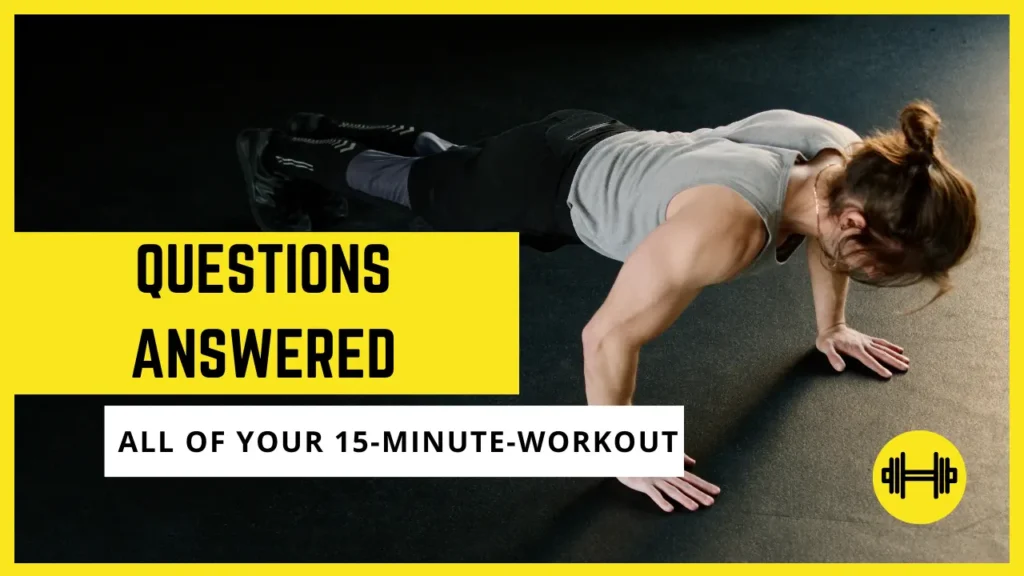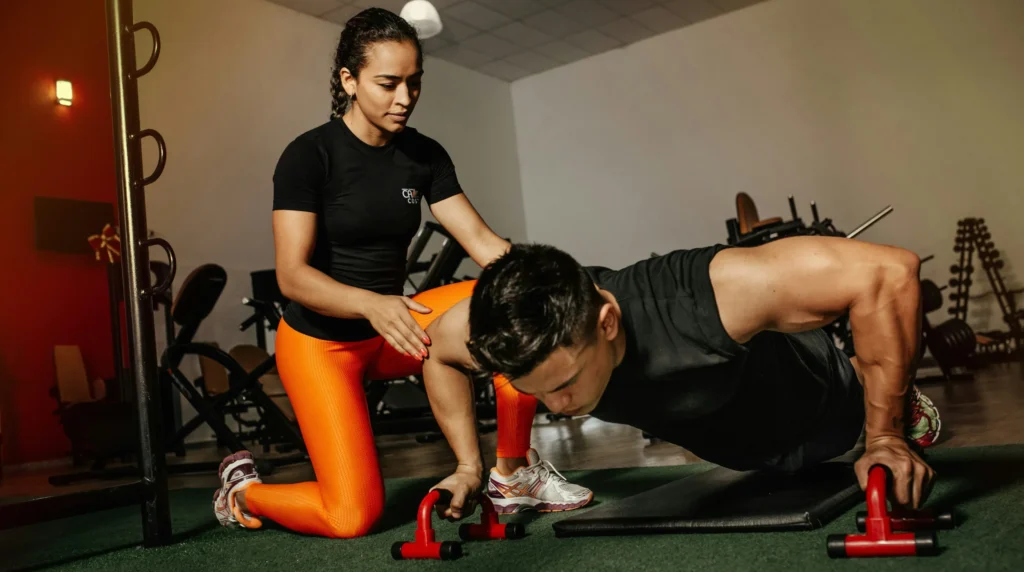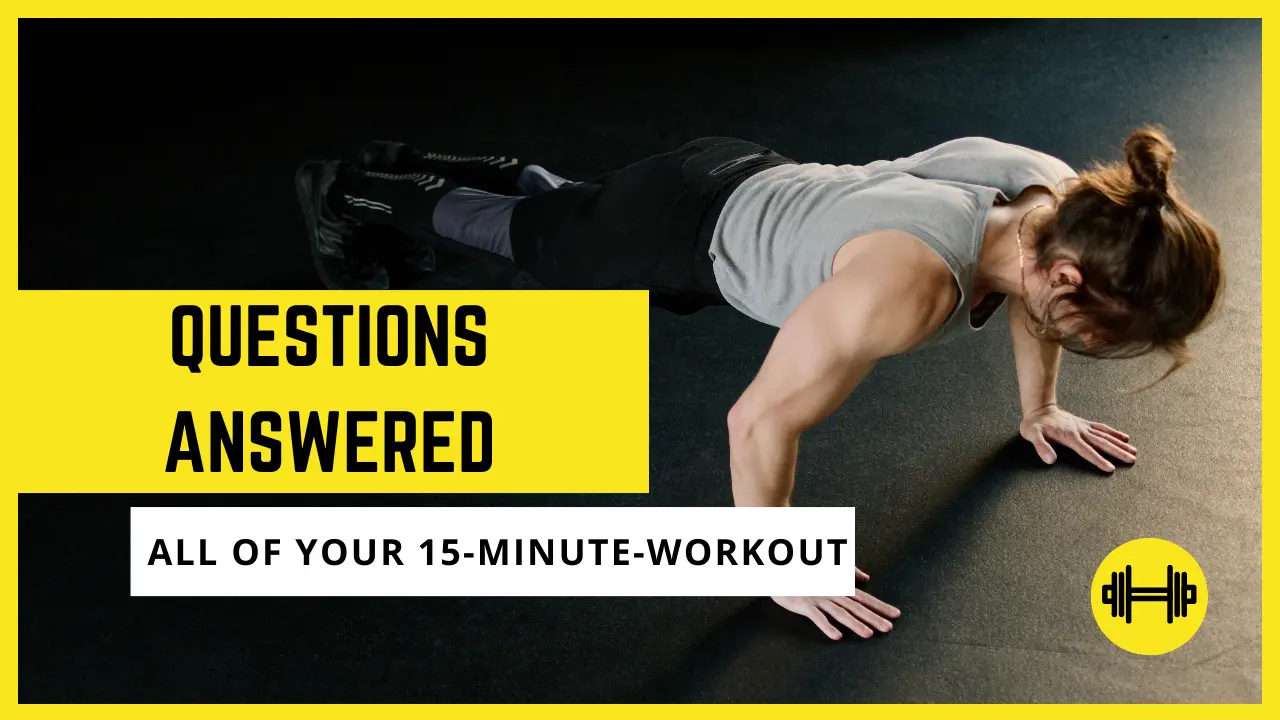
When people first hear the “15-Minute Secret,” they have questions. Lots of questions. How does it work? When do I see results? What equipment do I need? That’s why we’ve already put together a list of FAQs that will help you reap maximum rewards from your short workouts. We want you to be armed with all the answers you need to feel confident in the gym, at home, and when your friends say, “Fifteen minutes? No way!” You can just smile, finish your workout, and enjoy all that free time you have left in your day.
Fifteen minutes is half the standard recommendation of 30 minutes a day. How can it work?
Great question. Because it’s actually not half the standard recommendation. In fact, these 15 minutes exceed the standard exercise recommendation. It’s true. What most people don’t realize is that the 30 minutes a day the Centers for Disease Control and Prevention (CDC) recommends of is for moderate exercise, like brisk walking or washing your car. If you do moderate exercise only, you need to do 150 minutes a week, or about 30 minutes a day, to get benefits. But if you work out more vigorously, using the 15-minute secret, those official exercise recommendations are slashed in half to 75 minutes a week, or about 10 to 15 minutes a day. And in the end, those faster workouts work better. Remember: In a study by Australian researchers, exercisers who did 20-minute workouts that included high-intensity sprints 3 days a week shed fat pounds while their peers who did 40 minutes of cardio actually gained weight.
Do I need to use a stopwatch?

No. To make the program easy, we’ve designed every workout to take 15 minutes or less. Now, if you take longer rest periods, your workout may extend a few minutes longer, but our goal in this book is to give you the most effective and efficient workout possible in just 15 minutes. On days when you might have more time, go ahead and add more circuits or double up on the workouts. That’s cool, too. But you don’t have to do that, and, in fact, trying to overreach might derail your progress altogether. A study in the International Journal of Sports Medicine found that women had a much better chance of sticking with an exercise routine if it was limited to just 15 minutes.
What should I eat before a workout?
You don’t need to have any special foods before your superfast workouts. In fact, because the workouts can be intense, especially the Superfast Fat Burning HIIT routines, it’s best not to have a belly full of food. If it’s been more than 3 hours since you’ve eaten, you might want to have a small snack, like half a banana or a handful of trail mix, just to raise your blood sugar and give you an energy boost 30 to 45 minutes before you plan on exercising.
How quickly will I see results?
Depending on which workouts you do, anywhere from 2 to 4 weeks. (If you combine two of the workouts into one 30-minute power session, you’ll be losing weight and sculpting even faster.) Since women tend to carry less weight in their upper bodies, if you do our workouts for arms, shoulders, and back, you’ll start to see new definition in as little as 2 weeks.
How much weight should I lift?
The short answer: More than you think. Study after study shows that women tend to err on the side of using weights that are way too light when they resistance train, especially newbies. In a study where novice weight lifters were allowed to select the weight of their choice for their exercise sessions, not a single volunteer chose one that was heavy enough to stimulate muscle growth. Stuart Phillips, PhD, of McMaster University in Hamilton, Ontario, put it to me more bluntly: “A woman doing traditional squats with 10-pound dumbbells is likely activating zero fast-twitch muscle fibers.” That’s bad news because these are the fibers that go first, says William Kraemer, PhD, professor of kinesiology, physiology, and neurobiology at the University of Connecticut in Storrs. “With age, you naturally lose this type of lean muscle tissue,” he says. “That loss doesn’t slow down if all you do is cardio and lift 5-pound dumbbells. Those fibers only respond to heavier loads.”
The good news is that by lifting heavy loads—such as 15-, 20-, even 25-pound weights depending on the exercise—occasionally (it doesn’t need to be, nor should it be, every time; your muscles need recovery), you can fire up those fast-twitch fibers and maintain (or regain) strength and shapely muscle tone. Before you shake your head and dismiss this as too hard, think about the last time you went grocery shopping or to the airport. I’m going to bet that your grocery bags were about 10 pounds each (at least)—and that overstuffed suitcase? Thirty pounds, easy. We women are far stronger than we give ourselves credit for being.
Here’s how to figure out a proper weight, using the bent-over row with dumbbells as an example: Grab, say, 20-pound dumbbells and do a set of 10 repetitions of the bent row. The weight is appropriate if you can do 8 or 9 reps with perfect form but you start to struggle or pull more slowly on the 9th or 10th rep. If you struggle earlier in the set or lose form by twisting your torso or trying to use momentum (i.e., cheating), the weight is too heavy. Try 15-pound weights.
How many times do I do each exercise?
You’ll find a range of set and rep recommendations in the Superfast Workouts. As a rule of thumb, you’ll be doing as many sets as you need to to complete about 25 to 30 repetitions for a muscle group. There’s an inverse relationship between sets and reps. If you’re doing a high number of reps, like 15, you’ll only do two sets. If you’re lifting heavier weights for fewer, like 8 to 10 reps, you’ll do 3 sets. The goal is to challenge your muscles for an appropriate amount of time no matter how many reps you’re performing. Simply follow the instructions for each workout.
Do I stop each between each exercise?
In general, no. Most of the Superfast Workouts are done circuit style, which means you do a series of exercises in succession without resting between sets, before starting from the top and completing the circuit again. There’s an important strategy behind this: Because you never let your heart rate come down between moves, you get a calorie-burning cardio workout as well as a muscle-firming strength challenge. Circuits are an extremely efficient way to exercise, which is why they make up the bulk of the workouts in this book. But don’t worry, your body will also be getting rest, it’s just active rest. These workouts are ordered so the exercises alternate between upper- and lower-body exercises. So, for example, you would do a squat followed by a chest press followed by a hip bridge followed by a dumbbell row and so forth, with little or no rest between them. That way your upper body gets a break while your lower body works.
You’ll also be doing supersets, which are similar to circuits except you flip-flop between pairs of exercises before moving on to the next pair. By working different muscle groups back-to-back with no rest between, you not only save precious time (that you would otherwise be using for recovery), but also, some experts believe, you increase the rate at which your body breaks down and rebuilds muscle protein, which in turn boosts your metabolism for hours afterward.
Can I do all my Superfast Workouts on consecutive days or should I spread them out?
Spread them out. You’ll be doing three resistance-training workouts per week. Those should be on alternate days, with a day of recovery between them. On “off” days you can choose specialty workouts like one of the healing workouts, such as headache relief or a foam roller stretch/massage workout. One day a week will be reserved for the HIIT workout of your choosing and 1 day is for complete rest.
Researchers at the University of Texas Medical Branch in Galveston have generated a tall body of research that confirms that this strategy of every-other-day-lifting works wonders for your metabolism. In short, they found that muscle protein synthesis, which is what happens as your muscles are being repaired (this also raises your metabolism), is elevated for 48 hours after a resistance-training bout. So if you hit the kettlebells Tuesday at 10 a.m., your body remains in muscle toning and firming mode until 2 days later, when muscle synthesis returns to normal. So Thursday at 10 a.m. it’s time to fire it up again with another workout.
What about cardio? Shouldn’t I be doing that four times a week to lose weight?
HIIT workouts are actually much better than traditional cardio for losing weight. But the truth is, even on your superfast resistance-training days, you’ll be raising your heart rate and getting your blood flowing, which counts as cardio. We now know that weight training and the sprint-type training characteristic of HIIT strengthens your heart and lungs, lowers blood pressure, controls cholesterol, and shapes up your cardiovascular system as well, if not better than, classic aerobic exercise. So nearly any workout you choose in this book will count as cardio.
And don’t worry, you’ll still be burning plenty of fat, even though you’re working well above the “fat burning” zone. Vigorous exercise may burn more stored carbs while you’re doing it, but it burns far more fat in the long run. Hard efforts trigger the release of hormones such as epinephrine that stimulate fat release from your fat cells. “Your body also responds to hard efforts by building more mitochondria and producing more fat-burning enzymes, so you become better at burning fat, not just glycogen [stored carbs] during exercise,” says HIIT researcher Martin Gibala, PhD, professor of kinesiology at McMaster University, whose research found that exercisers who did sprint work improved their VO2 max levels (how much oxygen the body is capable of using—a key element in fat burning) by 30 percent, identical to a group who slogged along for more than 90 minutes in the fat-burning zone. Even better, your metabolism stays set to high for up to five times longer after a hard workout than an easy one, so you’re torching fat long after you’re done.
Do I need to lift superslow?
Nope. In fact, you’ll make greater gains if you speed things up a bit and lift a little faster. “By picking up the pace, you recruit more of your unused fast-twitch muscle fibers, which take a lot of energy to move,” explains resistance-training researcher Scott Mazzetti, PhD, of Salisbury University in Salisbury, Maryland. Mazzetti and his coworkers found that when volunteers performed springy, split-second reps during their strength-training sessions, they recruited more muscle and increased their calorie burn by about 28 percent—that adds up to 72 extra calories, or the amount you’d burn walking a mile, over the course of a full-body workout. Ramping up your repetition rate also revs up your metabolism for hours after you’re done. The same study reported that fast pace reps boost afterburn, the calories you burn for about an hour after you’re finished, by 5 percent.
Should I join a gym?

You can. But you don’t need to. You can do many of the 15-minute workouts in your living room with minimal (sometimes no) equipment. And for a couple hundred bucks, you can put together the perfect home gym. But there’s no question that belonging to a good gym opens up a world of workout possibilities that would likely not exist at home. There also are some people (I am one) who simply work out harder and longer and give just a bit more in a gym environment. Many women are also inspired by being surrounded by kindred spirits. A recent Stanford University study of nearly 3,000 women found that women (who are social by nature) are more motivated to exercise when they see others doing the same.
My advice: Start immediately. Do the workouts you can with what you’ve got and see how it goes. If you’re happy, but don’t feel like you have quite enough equipment to get the job done, check out “What gear do I need” and gear up if you need to. If it really isn’t working for you, it’s time to check out the local fitness clubs. Treat this “purchase” as you would shopping for a car. Do some research. Look around. Ask friends for their opinions. And most importantly, give the place a test drive. Any club worth your cash will give you a trial membership so you can come and use the facilities for a few days before making up your mind. Be sure to check it out during the times you’ll most likely be using it, especially if that’s during peak hours, like before and after work. The same gym that is pleasantly buzzing at 9 a.m. may be a madhouse at 6 p.m. Here are a few other factors to consider before signing on the dotted line at a health club or gym.
- Convenience. First and foremost, is the place convenient for you to get to? It doesn’t matter if you find the Shangri-la of fitness clubs. If it’s out of the way, you will not go. Period. Think about it: If it takes you 20 minutes to drive to the club and 20 to get home, plus time to change in the locker room, your 15-minute Superfast Workout has suddenly transformed into a superslow waste of time. Your health club or gym needs to be along your normal daily path and open during hours that you can easily accommodate. If not, take a pass and keep looking.
- Does it feel good? The right club should feel good immediately. First impressions count. If you walk in and think, “Wow,” that’s a good start. If you’re trying to talk yourself into it, leave.
- The staff. Committing to a gym is like buying a car, but you shouldn’t feel like you’re at a used-car dealership when you walk in the door. The staff and trainers should be sharp, credentialed, helpful, and engaging. But ultimately the place should sell itself. You shouldn’t be pressured with a hard sell.
- Affordability. Obviously, you shouldn’t blow your budget on a gym, but don’t shortchange yourself, either. Joining a cheap, so-so gym you never go to ultimately wastes more money than spending a few extra bucks a month on one you really love. Your health, strength, and fitness are sound investments.
If I work out after lunch, should I eat a recovery meal afterward?
You don’t have to scarf something immediately, as you would if you had skipped the preworkout lunch. The idea that you need to eat a fast-acting recovery meal or shake as soon as possible after training is rooted in research on endurance athletes who were doing 2½-hour workouts. Your 15-minute Superfast Workout—even if it’s really intense—won’t deplete your glycogen stores. Besides, you ate lunch, so your body isn’t running on empty.
How do the body-specific workouts work? I always heard you couldn’t lose weight in one place.
That’s a great question. You know, because 10,000 other trainers and I have told you a million times, that you can’t get rid of belly fat by doing dozens and dozens of crunches. That’s still true. You cannot spot reduce. But what you can do is spot tone, which many of the Superfast Workouts will do. When your muscles are untrained, they will be soft and, in the case of those affected by gravity, like your triceps and tush, saggy. If you have excess fat on the backs of your arms or on your behind, you will not make it go away by doing kickbacks and squats. But you will tighten, tone, and firm those muscles, which will improve the appearance of those areas. Because you’re burning calories during your workouts, you’re also shedding fat, which means you’ll be able to see those newly toned muscles shine through sooner.
How do I know if I’m working my muscles hard enough?
If you have the breath to ask, you may not be. Seriously, for strength workouts, use the guidelines under “How much weight should I lift?” The final repetition or two should be very tough. You should need to work hard to complete it with proper form and not be able to easily do more. For your HIIT workouts, simply use the talk test, which measures how many words you can spit out while you’re cranking out your efforts. Researchers have found to be very accurate way to judge exercise intensity without a heart rate monitor or other equipment. Those same researchers recommend using the Pledge of Allegiance as your guide. It works like this:
- Low-intensity activity (warmup): You should be able to say the entire pledge—all 31 words—comfortably, breathing at the usual pauses.
- Moderate aerobic activity: While working at this level you should be able to easily recite four to six words of the pledge at a time. You shouldn’t have to strain to get the words out of your mouth. You’ll be working at this intensity during most of the resistance-training circuits.
- High-intensity activity (intervals): This is an all-out effort (where you should be during the hardest parts of your HIIT workouts). When cranking it at this intensity, you should be able to speak only a word or two between breaths. (You’ll know you’re fully recovered from these efforts when you can say the whole pledge comfortably.)
Do I need a spotter?

Not often. Most of the workouts in this book involve bodyweight exercises or lightweight dumbbells that won’t get you into trouble. However, anytime you are using heavier weights or lifting a barbell over your head or chest (think bench press), it’s a good safety measure to ask a friend for a spot. Accidents happen every year, and you don’t want to add to the statistics.
Here are
7 common questions and answers about 15-minute workouts, perfect for a FAQ section:
1. Can I really get fit with just 15 minutes of exercise a day?
Answer: Yes! While longer workouts offer benefits, even short 15-minute sessions can improve your health and fitness. Consistency is key, so aim for daily 15-minute workouts when you can.
2. What types of exercises are best for a 15-minute workout?
Answer: Focus on compound movements that work multiple muscle groups simultaneously. This includes:
- Squats
- Push-ups
- Lunges
- Planks
- Burpees
3. Do I need any equipment?
Answer: No! Bodyweight exercises are perfect for short workouts. If you want to add resistance, consider simple items like:
- Dumbbells
- Resistance bands
- Filled water bottles
4. How should I structure my 15-minute workout?
Answer: Here are a few options:
- Full-body circuit: Perform 3-4 exercises back-to-back, rest, then repeat for 2-3 rounds.
- High-intensity interval training (HIIT): Alternate short bursts of intense exercise with recovery periods.
- Focus on one area: Dedicate the workout to a specific muscle group (legs, arms, core).
5. How often should I do 15-minute workouts?
Answer: Aim for at least 3-4 days a week. On other days, incorporate rest or lighter activity like walking.
6. Can I lose weight with 15-minute workouts?
Answer: Absolutely! Combining 15-minute workouts with a healthy diet will create the calorie deficit needed for weight loss.
7. Are 15-minute workouts good for beginners?
Answer: Yes! Short workouts are a great place to start your fitness journey. Listen to your body and modify exercises when needed.
You can also read my another blog


1 thought on “All of Your 15-Minute-Workout Questions Answered”